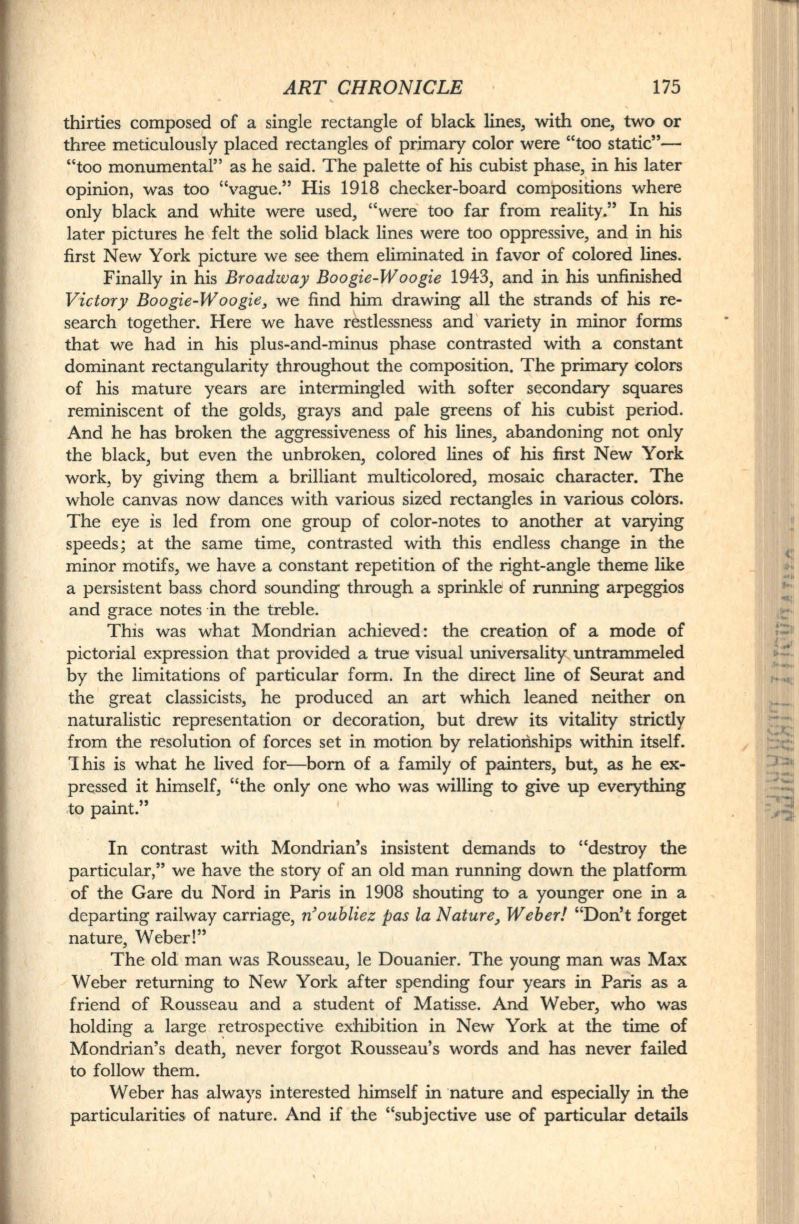
ART CHRONICLE
175
thirties composed of a single rectangle of black lines, with one, two or
three meticulously placed rectangles of primary color were "too static"–
"too monumental" as he said. The palette of his cubist phase, in his later
opinion, was too "vague." His 1918 checker-board compositions where
only black and white were used, "were too far from reality." In his
later pictures he felt the solid black lines were too oppressive, and in his
first New York picture we see them eliminated in favor of colored lines.
Finally in his
Broadway Boogie-Woogie
1943, and in his unfinished
Victory Boogie-Woogie,
we find him drawing all the strands of his re–
search together. Here we have
r~stlessness
and ' variety in minor forms
that we had in his plus-and-minus phase contrasted with a constant
dominant rectangularity throughout the composition. The primary colors
of his mature years are intermingled with softer secondary squares
reminiscent of the golds, grays and pale greens of his cubist period.
And he has broken the aggressiveness of his lines, abandoning not only
the black, but even the unbroken, colored lines of his first New York
work, by giving them a brilliant multicolored, mosaic character. The
whole canvas now dances with various sized rectangles in various colors.
The eye is led from one group of color-notes to another at varying
speeds; at the same time, contrasted with this endless change in the
minor motifs, we have a constant repetition of the right-angle theme like
a persistent bass chord sounding through a sprinkle of running arpeggios
and grace notes ·in the treble.
This was what Mondrian achieved: the creation of a mode of
pictorial expression that provided a true visual universality: untrammeled
by the limitations of particular form. In the direct line of Seurat and
the great classicists, he produced an art which leaned neither on
naturalistic representation or decoration, but drew its vitality strictly
from the resolution of forces set in motion by relationships within itself.
1
his is what he lived for-born of a family of painters, but, as he ex–
pressed it himself, "the only one who was willing to give up everything
to paint."
In contrast with Mondrian's insistent demands to "destroy the
particular," we have the story of an old man running down the platform
of the Gare du Nord in Paris in 1908 shouting to a younger one in a
departing railway carriage,
n'oubliez pas la Nature, Weber!
"Don't forget
nature, Weber!"
The old man was Rousseau, le Douanier. The young man was Max
Weber returning to New York after spending four years in Paris as a
friend of Rousseau and a student of Matisse. And Weber, who was
holding a large retrospective exhibition in New York at the time of
Mondrian's death; I).ever forgot Rousseau's words and has never failed
to follow them.
Weber has always interested himself
in
·nature and especially
in
the
particularities of nature. And if the "subjective use of particular details
/


